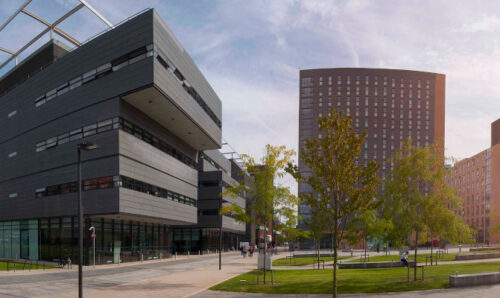Staff profile: Dr Draga Pihler-Puzovic
Meet the Department 15 September 2020
Dr. Draga Pihler-Puzovic is a senior lecturer and researcher in the Department of Physics & Astronomy, where she’s part of the Manchester Centre for Nonlinear Dynamics. She’s also the First Year Tutor.
 What do you teach? What part of that do you most enjoy teaching?
What do you teach? What part of that do you most enjoy teaching?
Currently I teach Computational Physics, which is an optional course in the 4th semester. It has a lab component, which means that I get to closely interact with students who are on the course. I really enjoy that interaction, because I typically deal with smart and enthusiastic people that happen to have similar interests to me. I like to be challenged by them. I also enjoy moments of live learning, when I can see new concepts sinking into my students’ heads.
You’re the First Year Tutor: what does that involve?
I coordinate work of personal tutors and first year lecturers, contribute to the department’s teaching strategy and oversee the first-year student’s welfare overall. I am also another point of contact for any first-year Physics student in addition to their personal tutor. I have a lot of experience of teaching in the first year, so I felt that I could contribute well to the department in that role.
What were your own degree and PhD in?
I have a degree in Mechanics and Applied Mathematics, and my PhD was in Applied Mathematics and Fluid Dynamics. One aspect of my research still focuses of the Physics of Fluids, but I have also branched out to other areas of Applied Mathematics and Physics. For example, I am currently working on understanding macroscopic properties of hard metamaterials.
What’s your area of research? What does that research look like? (ie, do you have a team, is it mostly theoretical or do you have experiments)
I work on many projects in Soft Matter and Nonlinear Physics, but there are two main themes – pattern formation due to instabilities and interactions between elastic structures and fluids. In Physics, I am a member of the Physics of Fluids and Soft Matter group which is relatively small, but very active. All members closely collaborate with each other. We also have collaborators in other departments, e.g. Mathematics and Chemistry, and other institutions. The work that we do in the group combines both experiments and theory, and I like using both of these complementary approaches.

A lot of people think the design on the windows of the Physics building (in the picture above) is something to do with cells, but it’s actually based on your work – can you tell is what it is?
This is a perfect example of patterns that we are interested in – and you could recreate this phenomenon in your kitchen. If you place two types of different particles on a horizontal tray (poppy seeds which are small and irregular in shape, and sugar balls, which are heavier and of a more regular shape, say), then start shaking the tray, the particles will separate (or segregate) and form stripes perpendicular to the direction of shaking. To describe the density of these stripy patterns, we tessellated the tray surface using Voronoi method and obtained the decals on the Schuster Annexe. These types of segregation phenomena are incredibly persistent in multicomponent granular material, and nuisance in many industries, i.e. food and pharmaceutical, so understanding segregation and describing it quantitatively is of significant practical importance.
What do you like to do outside of work?
I have two daughters so we spend a lot of time exploring museums and outdoors. Manchester is great for this – it is a vibrant urban centre and it is also very close to natural beauties of English countryside.



Leave a Reply